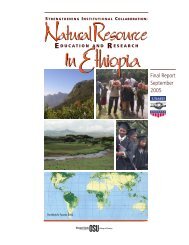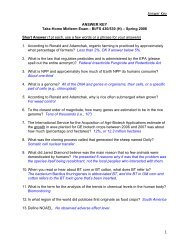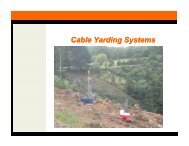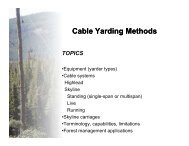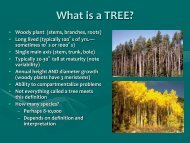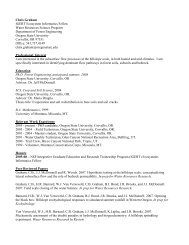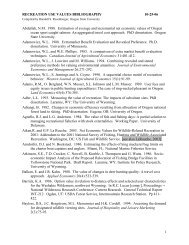Hillslope and Watershed Hydrology FE 537 Syllabus Fall 2004 Four ...
Hillslope and Watershed Hydrology FE 537 Syllabus Fall 2004 Four ...
Hillslope and Watershed Hydrology FE 537 Syllabus Fall 2004 Four ...
You also want an ePaper? Increase the reach of your titles
YUMPU automatically turns print PDFs into web optimized ePapers that Google loves.
infiltration model with a method for moving soil moisture downslope either by attempting to<br />
trace topographically controlled flowpaths with a local Darcy flux or developing a conceptual<br />
redistribution scheme (e.g. Topmodel).<br />
During this time, a new set of scientific questions have evolved, separate in focus <strong>and</strong><br />
intermediate in scale to traditional agricultural <strong>and</strong> water resources engineering. These dealt with<br />
problems in non-point source contaminants, acid rain, <strong>and</strong> other integrated watershed hydrologic<br />
processes <strong>and</strong> required a fuller underst<strong>and</strong>ing of the vertical distribution of flowpaths through<br />
hillslopes, their velocities <strong>and</strong> residence (or contact) times, <strong>and</strong> temporal dynamics on storm to<br />
seasonal time scales.Partially in response to these emerging problems, in the 1980s <strong>and</strong> 1990s,<br />
catchments (both hillslopes <strong>and</strong> streams) have been intensively studied by simultaneously<br />
monitoring the distribution <strong>and</strong> flux of water <strong>and</strong> chemicals at many locations in space <strong>and</strong> time.<br />
Technical advances in methods of measuring soil water distribution in the soil profile (TDR),<br />
soil <strong>and</strong> substrate structure (ground penetrating radar), <strong>and</strong> the use of chemical <strong>and</strong> isotopic<br />
tracers to source streamwater during this time have dramatically increased the amount of<br />
information available to study basic processes by which water moves through hillslopes. The<br />
information is not consistent in certain cases, between isotopic <strong>and</strong> chemical signals, with signals<br />
derived from more st<strong>and</strong>ard hydrometric methods.<br />
As our ability to measure hillslope flowpaths <strong>and</strong> the evolution of soil moisture patterns <strong>and</strong><br />
chemistry progressed, it was recognized that the concept of matrix flow as the dominant<br />
subsurface pathway may not be universally applicable. It is now recognized that the process of<br />
macropore flow <strong>and</strong> other preferential flowpaths through hillslopes are significant at least under<br />
certain conditions. Over the last 10-15 years, their has been a rapid advance in our ability to<br />
observe distributed processes in watersheds over a range of scales. The intensive monitoring of<br />
catchments has been made possible by automatic sampling <strong>and</strong> remote sensing techniques. The<br />
advent of isotopic methods to study the source <strong>and</strong> evolution of stormwater have added<br />
significantly to our knowledge base, sometimes yielding information that appears to conflict<br />
with previously held concepts <strong>and</strong> more traditional hydrometric data collection methods. These<br />
observations have raised many questions <strong>and</strong> issues about all of our commonly held concepts of<br />
streamflow generation <strong>and</strong> soil water dynamics.<br />
Current model development continues to seek to incorporate the distribution <strong>and</strong> dynamics of<br />
soil moisture <strong>and</strong> the set of possible flowpaths that become important under given conditions.<br />
However, at present there does not appear to be either a general underst<strong>and</strong>ing or consensus on<br />
how the dominant processes of water input, internal flow (pathway dynamics) <strong>and</strong> outflow<br />
(including evapotranspiration) interact <strong>and</strong> evolve on different hillslopes. At the same time, an<br />
underst<strong>and</strong>ing of these processes <strong>and</strong> their interactions have become critical to a set of pressing<br />
scientific questions regarding flood generation, water supply, water quality <strong>and</strong> l<strong>and</strong>/atmosphere<br />
interactions. This course will explore the state of the art of <strong>Hillslope</strong> <strong>Hydrology</strong> as it forms the<br />
foundation of the many water-mediated reactions that relate to it in the context of contemporary<br />
environmental problems.<br />
Learning Objectives of the Course:



